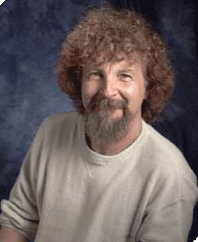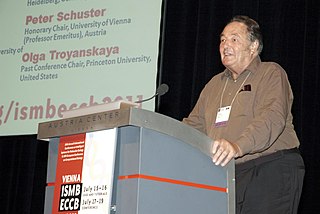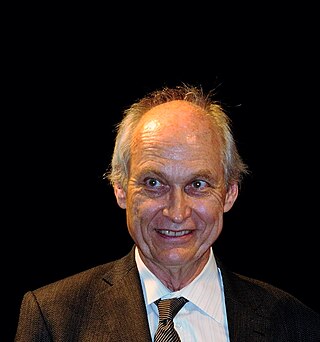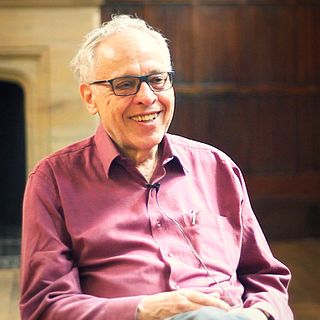Related Research Articles

Murray Gell-Mann was an American physicist who played a preeminent role in the development of the theory of elementary particles. Gell-Mann introduced the concept of quarks as the fundamental building blocks of the strongly interacting particles, and the renormalization group as a foundational element of quantum field theory and statistical mechanics. He played key roles in developing the concept of chirality in the theory of the weak interactions and spontaneous chiral symmetry breaking in the strong interactions, which controls the physics of the light mesons. In the 1970s he was a co-inventor of Quantum Chromodynamics (QCD) which explains the confinement of quarks in mesons and baryons and forms a large part of the Standard Model of elementary particles and forces.

Philip Warren Anderson was an American theoretical physicist and Nobel laureate. Anderson made contributions to the theories of localization, antiferromagnetism, symmetry breaking, and high-temperature superconductivity, and to the philosophy of science through his writings on emergent phenomena. Anderson is also responsible for naming the field of physics that is now known as condensed matter physics.

Wojciech Hubert Zurek is a theoretical physicist and a leading authority on quantum theory, especially decoherence and non-equilibrium dynamics of symmetry breaking and resulting defect generation.

Peter K. Schuster is a theoretical chemist known for his work with the German Nobel Laureate Manfred Eigen in developing the quasispecies model. His work has made great strides in the understanding of viruses and their replication, as well as theoretical mechanisms in the origin of life.

James Burkett Hartle was an American theoretical physicist. He joined the faculty of the University of California, Santa Barbara in 1966, and was a member of the external faculty of the Santa Fe Institute. Hartle is known for his work in general relativity, astrophysics, and interpretation of quantum mechanics.

Michael S. Turner is an American theoretical cosmologist who coined the term dark energy in 1998. He is the Rauner Distinguished Service Professor Emeritus of Physics at the University of Chicago, having previously served as the Bruce V. & Diana M. Rauner Distinguished Service Professor, and as the assistant director for Mathematical and Physical Sciences for the US National Science Foundation.
Stephen Louis Adler is an American physicist specializing in elementary particles and field theory. He is currently professor emeritus in the school of natural sciences at the Institute for Advanced Study in Princeton, New Jersey.
José F.F. Mendes is a Portuguese physicist and professor of physics, best known for his work and contributions to the field of network theory.Graduated from University of Porto in 1987. He earned a PhD in March 1995 from the same University under the direction of Eduardo Lage, the title of the thesis was "Dynamics of spins systems".

Joseph Ivor Silk FRS is a British-American astrophysicist. He was the Savilian Chair of Astronomy at the University of Oxford from 1999 to September 2011.

David D. Awschalom is an American condensed matter experimental physicist. He is best known for his work in spintronics in semiconductors.
Michael Ellis Fisher was an English physicist, as well as chemist and mathematician, known for his many seminal contributions to statistical physics, including but not restricted to the theory of phase transitions and critical phenomena. He was the Horace White Professor of Chemistry, Physics, and Mathematics at Cornell University. Later he moved to the University of Maryland College of Computer, Mathematical, and Natural Sciences, where he was University System of Maryland Regents Professor, a Distinguished University Professor and Distinguished Scholar-Teacher.
Mehran Kardar is an Iranian born physicist and professor of physics at the Massachusetts Institute of Technology (MIT), and co-faculty at the New England Complex Systems Institute (USA). He received his B.A. in physics from the University of Cambridge in 1979, and obtained his Ph.D. from MIT in 1983. Kardar is particularly known for the Kardar–Parisi–Zhang (KPZ) equation in theoretical physics, which has been named after him and his two coauthors: the Nobel Prize laureate Giorgio Parisi, and Yi-Cheng Zhang. He was awarded a Guggenheim Fellowship in 2001.

Steven Henry Strogatz, born August 13, 1959, is an American mathematician and the Susan and Barton Winokur Distinguished Professor for the Public Understanding of Science and Mathematics at Cornell University. He is known for his work on nonlinear systems, including contributions to the study of synchronization in dynamical systems, and for his research in a variety of areas of applied mathematics, including mathematical biology and complex network theory.

Charles W. Misner was an American physicist and one of the authors of Gravitation. His specialties included general relativity and cosmology. His work has also provided early foundations for studies of quantum gravity and numerical relativity.
David Pines was the founding director of the Institute for Complex Adaptive Matter (ICAM) and the International Institute for Complex Adaptive Matter (I2CAM), distinguished professor of physics, University of California, Davis, research professor of physics and professor emeritus of physics and electrical and computer engineering in the Center for Advanced Study, University of Illinois at Urbana–Champaign (UIUC), and a staff member in the office of the Materials, Physics, and Applications Division at the Los Alamos National Laboratory.
Mark Newman is an English–American physicist and Anatol Rapoport Distinguished University Professor of Physics at the University of Michigan, as well as an external faculty member of the Santa Fe Institute. He is known for his fundamental contributions to the fields of complex networks and complex systems, for which he was awarded the 2014 Lagrange Prize.
Harry Eugene Stanley is an American physicist and University Professor at Boston University. He has made seminal contributions to statistical physics and is one of the pioneers of interdisciplinary science. His current research focuses on understanding the anomalous behavior of liquid water, but he had made fundamental contributions to complex systems, such as quantifying correlations among the constituents of the Alzheimer brain, and quantifying fluctuations in noncoding and coding DNA sequences, interbeat intervals of the healthy and diseased heart. He is one of the founding fathers of econophysics.
Stanley Corrsin was an American physicist, fluid dynamicist, and Theophilus Halley Smoot Professor of Engineering at the Johns Hopkins University. He was known for his contributions in the field of fluid dynamics in general and turbulence in particular. He was a recipient of Fluid Dynamics Prize in 1983. Corrsin died of cancer on 2 June 1986 at the age of 66.
Cristopher David Moore, known as Cris Moore, is an American computer scientist, mathematician, and physicist. He is resident faculty at the Santa Fe Institute, and was formerly a full professor at the University of New Mexico.
Christopher Jarzynski is an American physicist and distinguished university professor at University of Maryland's department of chemistry and biochemistry, department of physics, and institute for physical science and technology, and fellow of the National Academy of Sciences. He is known for his contributions to non-equilibrium thermodynamics and statistical mechanics, for which he was awarded the 2019 Lars Onsager Prize. In 1997, he derived the now famous Jarzynski equality, confirmation of which was cited by the Nobel Committee for Physics as an application of one of the winning inventions of the 2018 Nobel Prize in physics—optical tweezers.
References
- ↑ "H. Eugene Stanley: Ph.D. Theses Supervised". polymer.bu.edu. Retrieved 27 May 2017.
- ↑ "SFI Professor Sid Redner Wins Major Physics Prize from the American Physical Society". Santa Fe Institute News. October 8, 2020.